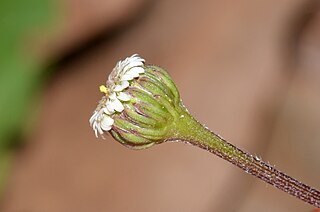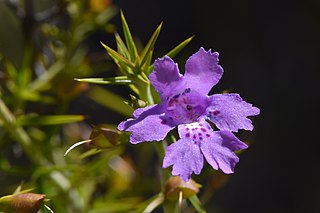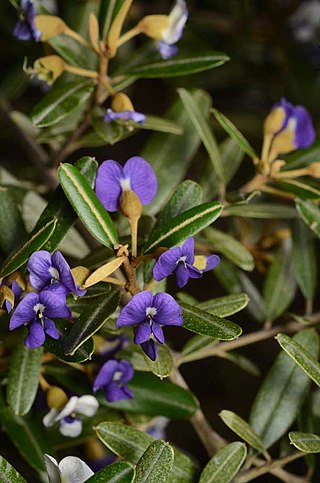
Acacia huegelii is a shrub belonging to the genus Acacia and the subgenus Phyllodineae native to Western Australia.

Darwinia vestita, commonly known as pom-pom darwinia, is a species of flowering plant in the family Myrtaceae and is endemic to the southwest of Western Australia. It is an erect, bushy shrub with crowded egg-shaped, oblong, or linear leaves and more or less spherical heads of white to reddish-pink flowers.

Boronia cymosa, commonly known as granite boronia, is a plant in the citrus family Rutaceae and is endemic to the south-west of Western Australia. It is an erect shrub with linear, more or less cylindrical leaves and groups of relatively small, pink four-petalled flowers arranged on branched flowering stems.

Boronia falcifolia, commonly known as the wallum boronia, is a plant in the citrus family, Rutaceae and is endemic to near-coastal areas of eastern Australia. It is a shrub with only a few stems, usually three-part leaves and bright pink, four-petalled flowers.

Lagenophora huegelii is a species of flowering plant in the family Asteraceae which is endemic to Western Australia. It was formerly considered to also grow in eastern Australia and Tasmania, though these populations are considered a separate species: Lagenophora gunniana.

Hemiandra linearis, commonly known as speckled snakebush, is a species of prostrate to ascending shrub that is endemic to the south-west of Western Australia.

Comesperma integerrimum is a twining shrub or climber in the family Polygalaceae.

Goodenia fasciculata is a species of flowering plant in the family Goodeniaceae and is endemic to the south-west of Western Australia. It an ascending shrub with bunched, narrow linear stem leaves and spikes of white flowers.

Goodenia pulchella is a species of flowering plant in the family Goodeniaceae and is endemic to the south-west of Western Australia. It is an erect to ascending herb with lance-shaped leaves mostly at the base of the plant, and racemes of yellow flowers.

Gompholobium aristatum is a species of flowering plant in the family Fabaceae and is endemic to the south-west of Western Australia. It an erect shrub that typically grows to a height of 10–80 cm (3.9–31.5 in). It flowers between July and December producing yellow, pea-like flowers. This species was first formally described in 1837 by George Bentham in Stephan Endlicher's Enumeratio plantarum quas in Novae Hollandiae ora austro-occidentali ad fluvium Cygnorum et in sinu Regis Georgii collegit Carolus Liber Baro de Hügel from specimens collected in the Swan River Colony. The specific epithet (aristatum) means "awned", referring to the leaves.

Hibbertia perfoliata is a species of flowering plant in the family Dilleniaceae and is endemic to Western Australia. It is a weak, ascending or prostrate, spreading shrub that typically grows to a height of up to 40 cm (16 in). It flowers from September to December or from January to March and has yellow flowers. The species was first formally described in 1837 by Stephan Endlicher from an unpublished description by Charles von Hügel and Endlicher's description was published in his book Enumeratio plantarum quas in Novae Hollandiae ora austro-occidentali ad fluvium Cygnorum et in sinu Regis Georgii collegit Carolus Liber Baro de Hügel. The specific epithet (perfoliata) means "perfoliate".

Kennedia carinata is a species of flowering plant in the family Fabaceae and is endemic to the south-west of Western Australia. It is a prostrate shrub with trifoliate leaves and reddish-purple, pea-like flowers.

Lechenaultia floribunda, commonly known as free-flowering leschenaultia, is a species of flowering plant in the family Goodeniaceae and is endemic to the south-west of Western Australia. It is an openly-branched shrub or subshrub with crowded, narrow, fleshy leaves and compact groups of pale blue to pale mauve or creamy white flowers.
Lasiopetalum cordifolium, is a species of flowering plant in the family Malvaceae and is endemic to the south-west of Western Australia. It is an erect shrub with hairy stems, heart-shaped leaves and pink, cream-coloured or white flowers.

Sphaerolobium alatum is a species of flowering plant in the family Fabaceae and is endemic to the south of Western Australia. It is a slender, leafless shrub with yellow and reddish-brown flowers from September to November.
Sphaerolobium fornicatum is a species of flowering plant in the family Fabaceae and is endemic to the far south-west of Western Australia. It is a leafless shrub that typically grows to a height of 0.1–1 m and has yellow or orange and red flowers from October to January.

Sphaerolobium grandiflorum is a species of flowering plant in the family Fabaceae and is endemic to the south of Western Australia. It is an erect, slender, leafless shrub with red, yellow and orange flowers.

Sphaerolobium linophyllum is a species of flowering plant in the family Fabaceae and is endemic to the south of Western Australia. It is a prostrate to ascending shrub with a few narrowly linear leaves and red, yellow and orange flowers.

Spyridium majoranifolium is a species of flowering plant in the family Rhamnaceae and is endemic to the south of Western Australia. It is a shrub that typically grows to a height of 0.1–1.6 m and has white to cream-coloured or yellow flowers from February to October. It grows on coastal dunes and stony hillsides in near-coastal areas in the Esperance Plains, Jarrah Forest and Warren bioregions of southern Western Australia.

Hovea longipes is a species of flowering plant in the family Fabaceae and is endemic to north-eastern Australia. It is a shrub or tree with narrowly elliptic to lance-shaped leaves, and deep indigo-blue and white, pea-like flowers.


















